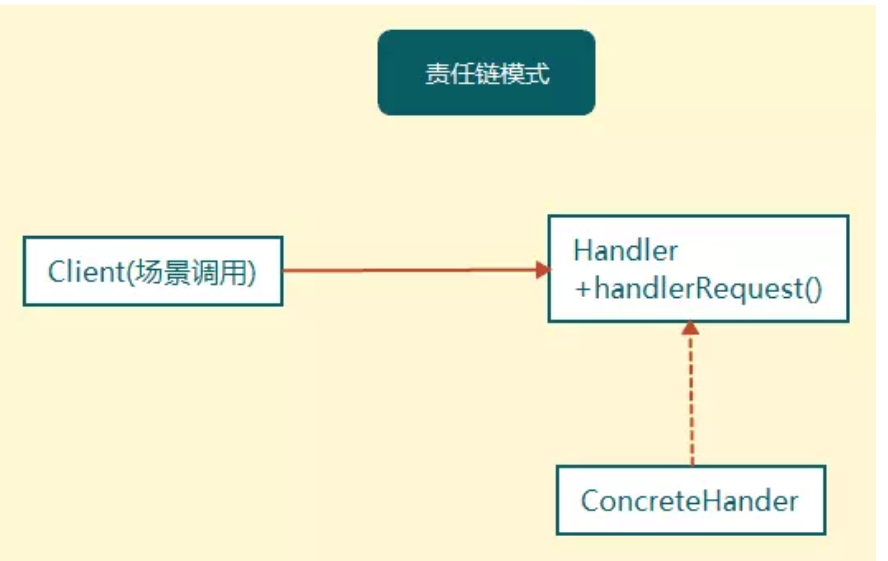定义
顾名思义,责任链模式(Chain of Responsibility Pattern)为请求创建了一个接收者对象的链。这种模式给予请求的类型,对请求的发送者和接收者进行解耦。这种类型的设计模式属于行为型模式。 在这种模式中,通常每个接收者都包含对另一个接收者的引用。如果一个对象不能处理该请求,那么它会把相同的请求传给下一个接收者,依此类推。
模板

client: 有待处理的请求(Request)
Handler: 处理请求的抽象类/接口
Concretehandler 具体的请求处理类,这里只画了一个,其实有多个,他们共同组成一个链条。
实例
下面举一个讲解责任链模式中使用较多的例子。

AbstractLogger(相当于Handler)
public abstract class AbstractLogger {
public static int INFO = 1;
public static int DEBUG = 2;
public static int ERROR = 3;
protected int level;
//责任链中的下一个元素
protected AbstractLogger nextLogger;
public void setNextLogger(AbstractLogger nextLogger){
this.nextLogger = nextLogger;
}
public void logMessage(int level, String message){
if(this.level <= level){
write(message);
}
if(nextLogger !=null){
nextLogger.logMessage(level, message);
}
}
abstract protected void write(String message);
}
ConsoleLogger(相当于ConcreteHandler)
public class ConsoleLogger extends AbstractLogger {
public ConsoleLogger(int level){
this.level = level;
}
@Override
protected void write(String message) {
System.out.println("Standard Console::Logger: " + message);
}
}
ErrorLogger(相当于ConcreteHandler)
public class ErrorLogger extends AbstractLogger {
public ErrorLogger(int level){
this.level = level;
}
@Override
protected void write(String message) {
System.out.println("Error Console::Logger: " + message);
}
}
FileLogger(相当于ConcreteHandler)
public class FileLogger extends AbstractLogger {
public FileLogger(int level){
this.level = level;
}
@Override
protected void write(String message) {
System.out.println("File::Logger: " + message);
}
}
ChainPatternDemo(相当于Client)
public class ChainPatternDemo {
// 构造链式结构
private static AbstractLogger getChainOfLoggers(){
AbstractLogger errorLogger = new ErrorLogger(AbstractLogger.ERROR);
AbstractLogger fileLogger = new FileLogger(AbstractLogger.DEBUG);
AbstractLogger consoleLogger = new ConsoleLogger(AbstractLogger.INFO);
errorLogger.setNextLogger(fileLogger);
fileLogger.setNextLogger(consoleLogger);
return errorLogger;
}
public static void main(String[] args) {
AbstractLogger loggerChain = getChainOfLoggers();
loggerChain.logMessage(AbstractLogger.INFO, "This is an information.");
loggerChain.logMessage(AbstractLogger.DEBUG,
"This is a debug level information.");
loggerChain.logMessage(AbstractLogger.ERROR,
"This is an error information.");
}
}
使用场景
1、有多个对象处理同一个请求,具体哪一个对象处理在运行时自行确定
2、在不明白具体接收者的情况下,向多个对象中的一个提交请求
3、代码块中存在多个if-else语句的情况下,可以考虑使用责任链模式进行重构
优点
1、降低请求发送者和接收者之间的耦合度
2、简化了对象、使对象不清除链的结构
3、增加了对象指派职责的灵活度、增强了可扩展性
4、将多个条件语句进行分散到各个具体处理类中,增加代码的可阅读性。使代码更加清晰,责任更明确
缺点
降低程序的性能。每个请求都是从链头遍历到链尾,当链比较长的时候,性能会大幅下降。
不易于调试。由于该模式采用了类似递归的方式,调试的时候逻辑比较复杂。
其它应用场景
- okttp中定义了网络拦截器就是一种责任链模式
- 服务端对消息的处理也是一种责任链模式
来源:https://www.cnblogs.com/NeilZhang/p/12148257.html